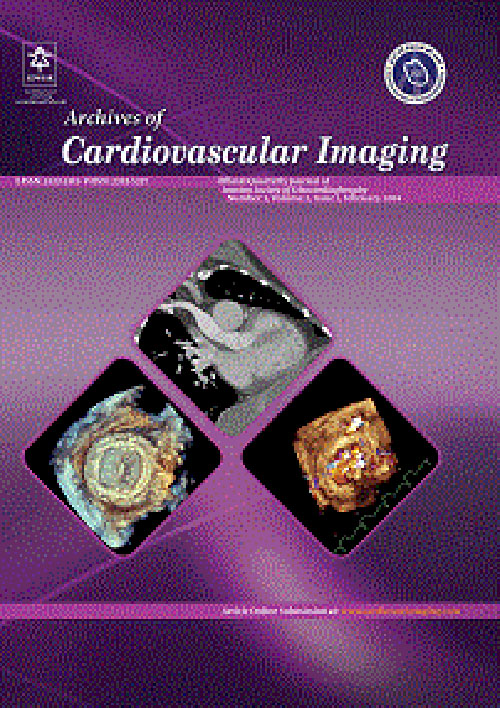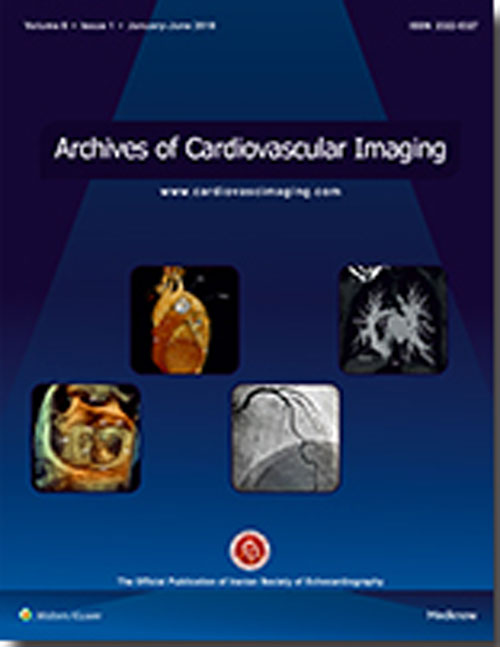فهرست مطالب

Archives Of Cardiovascular Imaging
Volume:4 Issue: 1, Feb 2016
- تاریخ انتشار: 1394/12/12
- تعداد عناوین: 6
-
-
Page 3IntroductionArterial involvement in Behcets disease has been previously described. We report a rare case of a large and long-segment thoracoabdominal aneurysm, which was associated with Behcets disease and had an unfavorable evolution..Case PresentationA 23-year-old man was diagnosed with Behcets disease, as revealed by a carotid aneurysm, and was treated with a prosthetic graft reconstruction as well as immunosuppressive therapy. The patient was lost to follow-up. He stopped the medications of his own will 1 month after his discharge from the hospital. Two years later, he presented with chest pain of 1 weeks duration. A large aneurysm involving a long aorta segment from the sinus of Valsalva to the abdominal aorta above the renal arteries was identified by computed tomography angiography. Unfortunately, the patient died despite immunosuppressive therapy and before any surgical or endovascular intervention could be performed..ConclusionsThis rare observation supports the role of immunosuppressive therapy in preventing the recurrence of life-threatening vascular lesions in the management of Behcets disease..Keywords: Behcets, Vascular Disease, Thoracoabdominal Aneurysm
-
Page 4Backgroundβ-thalassemia is an inherited disorder of β-globin biosynthesis. Dysfunction in hemoglobin chain production, ineffective erythropoiesis, and hemolysis occur in β-thalassemia. Pulmonary arterial hypertension (PAH) is increasingly detected in patients with β-thalassemia, and splenectomy which decreases the need for blood transfusion increases the pulmonary artery pressure (PAP)..ObjectivesThis study aimed to assess the PAP in patients with β-thalassemia (male or female and major or intermedia) who had undergone splenectomy..MethodsA total of 137 patients suffering from β-thalassemia were evaluated during the study. All subjects were referred for cardiac evaluation. Clinical history, presence of cardiac symptoms, and previous splenectomy were noted. Standard M-mode, 2D, and Doppler echocardiographic examinations were performed for all subjects. Patients with a tricuspid regurgitant jet velocity (TRV) ≥ 2.5 m/s were considered at risk for PAH..ResultsAverage age of the patients was 21.15 ± 6.68 years. No significant difference was observed in the PAP between the 2 groups of thalassemia major and intermedia and also the 2 sex groups. Indeed, 6.6% of the patients had an increased PAP. The significant finding of the study was that the patients who had had splenectomy were significantly at an increased risk of PAH (P = 0.046)..ConclusionsThe etiology of PAH in thalassemia is multifactorial such as inflammatory mediators. Also, the absence of the spleen plays an important role in developing a high TRV and PAH..Keywords: Thalassemia, Splenectomy, Pulmonary Hypertension
-
Page 5BackgroundHigh-intensity interval training (HIIT) is a time-efficient alternative to traditional prolonged training. In contrast to ample evidence describing the effects of prolonged training, there are few data describing cardiovascular adaptations arising from HIIT interventions..ObjectivesThe present study aimed to evaluate the effects of HIIT on heart morphology and function in untrained male subjects..
Patients andMethodsTwenty-two young men (age = 23.34 ± 2.56 years, weight = 72.47 ± 12.01 kg, and height = 174.10 ± 5.75 cm) were recruited and randomly assigned into control (n = 10) and HIIT (n = 12) groups. Echocardiography was used to evaluate left ventricular mass (LVM), end-systolic volume (ESV), end-diastolic volume (EDV), interventricular septal wall thickness (IVSWT), stroke volume, and ejection fraction (EF). Also, the Bruce treadmill test was employed to estimate VO2max..ResultsThe HIIT subjects showed a significant increase in EDV (P = 0.001), LVM (P = 0.002), stroke volume (P = 0.003), and EF (P = 0.001). However, there was no change in ESV due to HIIT (P = 0.916). Additionally, following HIIT, IVSWT (P = 0.227), despite exhibiting a slight increase, was not significantly different from pre-training levels..ConclusionsHIIT in previously untrained subjects led to a significant change in left ventricle (LV) morphology, correlating with improvement in aerobic power (VO2max). Cardiac remodeling was characterized by an increased EDV and a similar increase in LVM..Keywords: Echocardiography, High, Intensity Interval Training, Cardiac Morphology -
Page 6BackgroundCurcumin, a yellow substance found in turmeric, has not only antioxidative features and beneficial effects in the treatment of cancer, liver, heart, and pulmonary diseases but also anti-inflammatory and anticoagulative effects. This chemical has cardioprotective effects too..ObjectivesIn this study, we examined the effects of curcumin on left ventricular (LV) function in patients receiving dialysis for chronic renal failure..MethodsThis study is a double-blind, placebo-controlled trial conducted on 35 patients with chronic renal failure undergoing dialysis in the dialysis center of Baqiyatallah hospital. The patients were randomly divided into 2 groups: the curcumin group (n = 20) and the control group (n = 15). The curcumin group received curcumin capsules at a dose of 500 mg every 8 hours for 6 weeks (1500 mg/d) and the control group received a placebo for 6 weeks at the same dose. Echocardiography was done before the use of the drug and once after the 6th week. Also, the ejection fraction (EF), representing LV function and size, was measured in both groups..ResultsThe mean age was 44.2 ± 13.4 years for the curcumin group and 45.4 ± 6.2 years for the placebo group. The study population comprised 22 male and 13 female patients. There were no significant differences regarding demographic variables such as age, sex, and body mass index between the 2 groups. In the curcumin group, LVEF based on the volume changed from 50.6% ± 7.1% to 51.5% ± 6.8% (P = 0.130). In the curcumin group, LVEF based on the diameter changed from 51.8% ± 3.8% to 52.4% ± 3.5% (P = 0.112). The changes in the mean EF before and after the intervention were not significant in each group. The EF, based on ventricular volume and diameter, was not significantly different between the 2 groups. In addition, the pulmonary artery pressure mean in both groups did not significantly change after the intervention (P > 0.05)..ConclusionsThe administration of curcumin in patients undergoing dialysis had no positive effects on enhancing LVEF and LV function. Further research is required to shed sufficient light on this issue..Keywords: Curcumin, Left Ventricular Ejection Fraction, End, Stage Renal Disease, Dialysis


